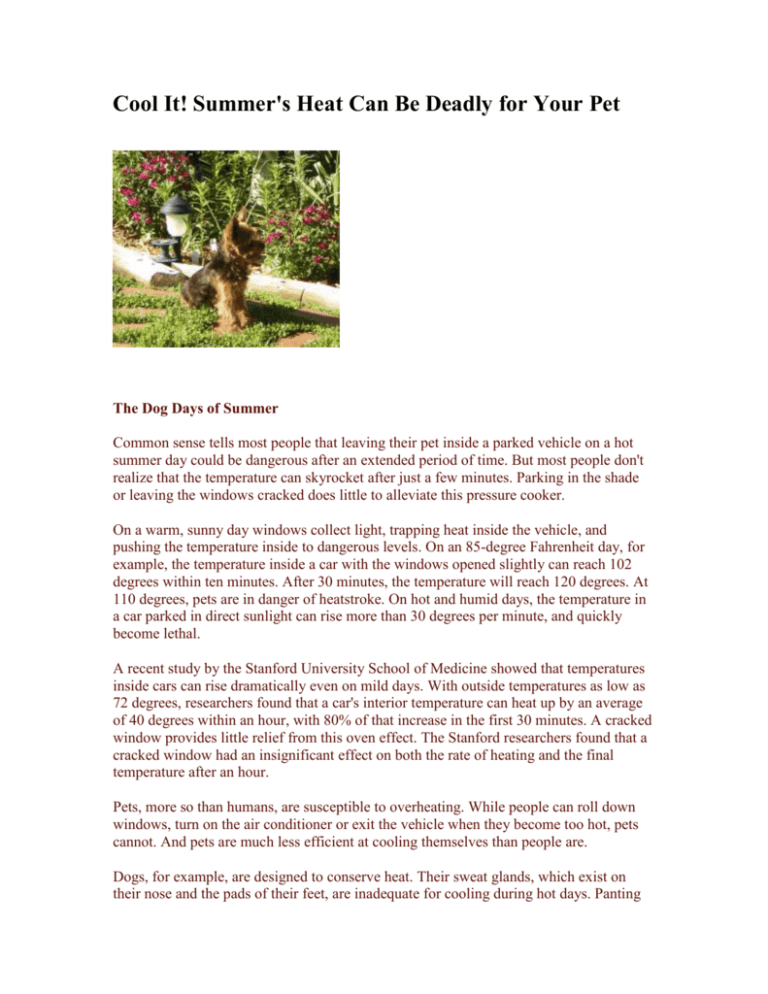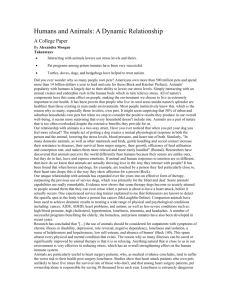News-Letter
advertisement

Cool It! Summer's Heat Can Be Deadly for Your Pet The Dog Days of Summer Common sense tells most people that leaving their pet inside a parked vehicle on a hot summer day could be dangerous after an extended period of time. But most people don't realize that the temperature can skyrocket after just a few minutes. Parking in the shade or leaving the windows cracked does little to alleviate this pressure cooker. On a warm, sunny day windows collect light, trapping heat inside the vehicle, and pushing the temperature inside to dangerous levels. On an 85-degree Fahrenheit day, for example, the temperature inside a car with the windows opened slightly can reach 102 degrees within ten minutes. After 30 minutes, the temperature will reach 120 degrees. At 110 degrees, pets are in danger of heatstroke. On hot and humid days, the temperature in a car parked in direct sunlight can rise more than 30 degrees per minute, and quickly become lethal. A recent study by the Stanford University School of Medicine showed that temperatures inside cars can rise dramatically even on mild days. With outside temperatures as low as 72 degrees, researchers found that a car's interior temperature can heat up by an average of 40 degrees within an hour, with 80% of that increase in the first 30 minutes. A cracked window provides little relief from this oven effect. The Stanford researchers found that a cracked window had an insignificant effect on both the rate of heating and the final temperature after an hour. Pets, more so than humans, are susceptible to overheating. While people can roll down windows, turn on the air conditioner or exit the vehicle when they become too hot, pets cannot. And pets are much less efficient at cooling themselves than people are. Dogs, for example, are designed to conserve heat. Their sweat glands, which exist on their nose and the pads of their feet, are inadequate for cooling during hot days. Panting and drinking water helps cool them, but if they only have overheated air to breathe, dogs can suffer brain and organ damage after just 15 minutes. Short-nosed breeds, like pugs and bulldogs, young pets, seniors or pets with weight, respiratory, cardiovascular or other health problems are especially susceptible to heat-related stress. Pets on the Move While it used to be that our animals stayed home to guard the couch, increasingly dogs, cats and other pets are going along for the ride, whether tagging along during errands or putting in major mileage during the family vacation. The high number of animals on the road means that awareness and vigilance are essential for protecting pets from parking-lot peril. Taking Action In case of an emergency, it's important to be able to identify the symptoms of heat stress caused by exposure to extreme temperatures. Check the animal for signs of heavy panting, glazed eyes, a rapid heartbeat, restlessness, excessive thirst, lethargy, fever, dizziness, lack of coordination, profuse salivation, vomiting, a deep red or purple tongue, and unconsciousness. If the animal shows symptoms of heatstroke, take steps to gradually lower her body temperature immediately. Follow these tips, and it could save her life: Move the animal into the shade or an air-conditioned area. Apply ice packs or cold towels to her head, neck, and chest or immerse her in cool (not cold) water. Let her drink small amounts of cool water or lick ice cubes. Take her directly to a veterinarian. In many states, it's against the law to leave a pet unattended in a parked vehicle in a manner than endangers the health or safety of the animal. Despite these laws, not to mention a basic common sense that should guide most pet owners during the summer, companion animals die every year from heatstroke. The worst part is knowing that each death was preventable. That's why sharing this information is so important. Summers, after all, are truly supposed to be carefree.







